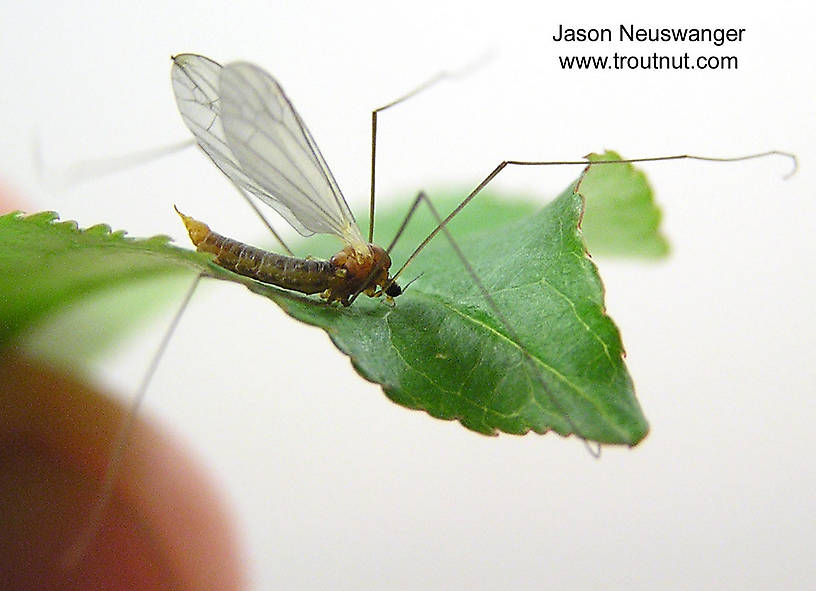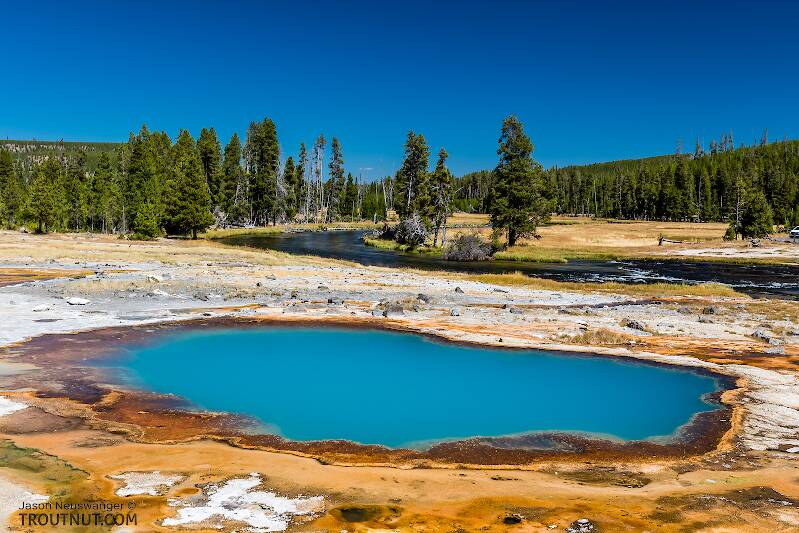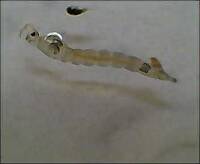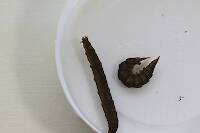
Salmonflies
Pteronarcys californica
The giant Salmonflies of the Western mountains are legendary for their proclivity to elicit consistent dry-fly action and ferocious strikes.
Featured on the forum

This one was surprisingly straightforward to identify. The lack of a sclerite at the base of the lateral hump narrows the field quite a bit, and the other options followed fairly obvious characteristics to Clostoeca, which only has one species, Clostoeca disjuncta.

Troutnut is a project started in 2003 by salmonid ecologist Jason "Troutnut" Neuswanger to help anglers and
fly tyers unabashedly embrace the entomological side of the sport. Learn more about Troutnut or
support the project for an enhanced experience here.

This is a small cranefly species.
Manny
Posts: 1
Posts: 1
Manny on Jun 9, 2007June 9th, 2007, 5:31 pm EDT
I was fly fishing a tailwater in Indiana when I noticed a {hatch} of what I thought were sulfers(dorothea,invaria). But after further inspection they had the makup of a crane fly and also were a pale yellowish color. Could this be a crane fly species?
Troutnut on Jun 9, 2007June 9th, 2007, 5:36 pm EDT
Definitely. Small pale yellow craneflies are especially common on trout streams. I don't know any more about those species, but I'm sure trout go for them at times.
Jason Neuswanger, Ph.D.
Troutnut and salmonid ecologist
Troutnut and salmonid ecologist
Martinlf on Jun 9, 2007June 9th, 2007, 5:54 pm EDT
Yes, Flyfisher's Paradise in State College even has its own patterns for orange and yellow craneflies, and I've had very good luck with the flies in autumn.
"He spread them a yard and a half. 'And every one that got away is this big.'"
--Fred Chappell
--Fred Chappell
Konchu on Jun 10, 2007June 10th, 2007, 1:24 am EDT
Cranefly larvae are often really huge, and probably a juicy treat for a hungry fish. What kinds of patterns mimic these, and how commonly are they used?
Taxon on Jun 10, 2007June 10th, 2007, 4:51 am EDT
Konchu-
Probably, the vast majority of flyfishers have never specifically set about to imitate crane fly larvae. However, 3-4XL hooks utilizing a dubbed body of muskrat fur would be standard fare for such imitation.
Two patterns suggested in Western Hatches by Hafele/Hughes are Polly Roseborough's Muskrat, and Ernest Schwiebert's Western Crane Fly Larva. The imitations are said to be most effective fished tumbling along the bottom, shortly following a spate, which has disturbed their larval habitat.
Probably, the vast majority of flyfishers have never specifically set about to imitate crane fly larvae. However, 3-4XL hooks utilizing a dubbed body of muskrat fur would be standard fare for such imitation.
Two patterns suggested in Western Hatches by Hafele/Hughes are Polly Roseborough's Muskrat, and Ernest Schwiebert's Western Crane Fly Larva. The imitations are said to be most effective fished tumbling along the bottom, shortly following a spate, which has disturbed their larval habitat.
Shawnny3 on Jun 10, 2007June 10th, 2007, 1:46 pm EDT
Another good crane fly larval imitation is the Walt's Worm. The larval crane fly imitations I've seen are basically really vaguely buggy, cigar-shaped imitations that work for both caddis and crane fly larva. Perhaps it's not a lucrative enough hatch to try to imitate them specifically (or they may just be similar enough to caddisflies that most fisherman simply imitate both with the same larval imitation), but I can recall days her in Central PA when crane flies were the only things flying around.
-Shawn
-Shawn
Jewelry-Quality Artistic Salmon Flies, by Shawn Davis
www.davisflydesigns.com
www.davisflydesigns.com
Invicta on Jun 10, 2007June 10th, 2007, 2:01 pm EDT
I agree with Taxon, the vast majority of tiers do not imitate a crane fly larva, but they should. In the waters that I consider my backyard (Golden Trout Wilderness, Sequoia NF, CA) a crane fly larva is a mandatory summer pattern for the meadow sections of streams. One of the local species is the Giant Western Crane fly (Holorusia rubiginosa). A proper imitation of a mature larva may go up to 50mm by mid-summer, which I have used only in the largest of the surrounding streams, but then it has accounted for rainbows over 22”. Most often we use smaller patterns. One I can recommend, to be added to the pattern listed by Shawn, can be found at Charlie Craven’s website, under Crane fly larva, it's the one I use:
http://www.charliesflyboxinc.com
If you are unsure of the size, stay small.
John
http://www.charliesflyboxinc.com
If you are unsure of the size, stay small.
John
Quick Reply
Related Discussions
Topic
Replies
Last Reply
2
Apr 7, 2012
by Crepuscular
by Crepuscular







